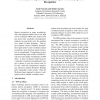Free Online Productivity Tools
i2Speak
i2Symbol
i2OCR
iTex2Img
iWeb2Print
iWeb2Shot
i2Type
iPdf2Split
iPdf2Merge
i2Bopomofo
i2Arabic
i2Style
i2Image
i2PDF
iLatex2Rtf
Sci2ools
ACL
2007
2007
Vocabulary Decomposition for Estonian Open Vocabulary Speech Recognition
Speech recognition in many morphologically rich languages suffers from a very high out-of-vocabulary (OOV) ratio. Earlier work has shown that vocabulary decomposition methods can practically solve this problem for a subset of these languages. This paper compares various vocabulary decomposition approaches to open vocabulary speech recognition, using Estonian speech recognition as a benchmark. Comparisons are performed utilizing large models of 60000 lexical items and smaller vocabularies of 5000 items. A large vocabulary model based on a manually constructed morphological tagger is shown to give the lowest word error rate, while the unsupervised morphology discovery method Morfessor Baseline gives marginally weaker results. Only the Morfessor-based approach is shown to adequately scale to smaller vocabulary sizes.
ACL 2007 | Computational Linguistics | Speech Recognition | Vocabulary Decomposition | Vocabulary Decomposition Methods |
Related Content
| Added | 29 Oct 2010 |
| Updated | 29 Oct 2010 |
| Type | Conference |
| Year | 2007 |
| Where | ACL |
| Authors | Antti Puurula, Mikko Kurimo |
Comments (0)

